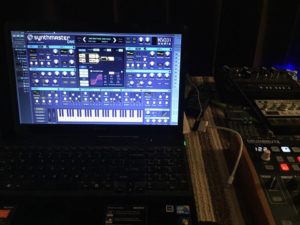Anyone searching for a flexible software synthesizer with a wide array of sonic possibilities at a great price need look no further than SynthMaster One. Developed by KV331 Audio, this soft synth is also easy to use, with an entire interface that fits on one screen. Supporting most popular plug-in formats and including a standalone Windows version, SynthMaster One is worthy of your attention.
SynthMaster One Features
- Two Stereo Oscillators each with its own Flexible Sub-Oscillator
- Four ADSR Envelopes, Two Filters, Two LFOs
- 16-step Arpeggiator/Sequencer supports Different Time Signatures
- Wavetable Synthesis with User-Defined Tables
- Eleven Effects with Six Inserts
- Microtuning
- Modulation Matrix
- Easy to Navigate Preset Browser
- 500 “Factory” Presets
Effectively a condensed version of KV331’s award-winning SynthMaster plug-in, SynthMaster One stands out as one of the best values in the synthesizer plug-in world – its street price is $79. Let’s dive in to the details to see if it makes sense in your music arsenal.
A Straightforward Synth Interface
SynthMaster One manages to fit an entire synth architecture on one, easy-to-follow page. I had to run it FL Studio’s “detached” mode to get everything on my 15-inch laptop’s screen. Still, nearly all functionality is accessible from this one screen.

The synth controls – oscillators, envelopes, filters, etc. – dominate the main screen with a window in the middle used for effects, filter routing, and the arpeggiator/sequencer. The layout is clear and logical, and should be intuitive for anyone familiar with subtractive synthesis. A virtual keyboard and buttons accessing utility functionality reside at the bottom.
A variety of skins allow some customization to the interface, but the contrast of the default setting works best in most low-light situations. It is simple enough to switch skins.
At the top of the screen there is a navigation area for switching between presets. A dedicated preset browser allows searching using a host of metadata. Users familiar with Massive’s patch browser will feel right at home.
Flexible Oscillators add Sonic Complexity
The heart of SynthMaster One’s architecture lies in its two flexible oscillators. Each of them comes with its own suboscillator. In addition to serving the traditional function of adding bass heft to a patch, you are able to use these subs for a variety of modulation functions, including ring, FM, and more.
With oscillator waveforms that run the gamut from traditional analog-style to samples to wavetables, you have a nearly unlimited amount of sounds at your fingers. 16 waveshaping algorithms let you modify the waveforms in a host of ways, such as filter, sync, bitcrush, and pulse.
The Unison setting lets you stack up to 16 detunable oscillators for supersaw and chorusing effects. Additional settings control the detuning, spread, and more for the stack. Remember that these are stereo oscillators, as noted by the pan control. Free oscillator mode and ability to add “drifts” enhance the synth’s ability to simulate the vagaries of vintage analog devices.
The support for wavetable synthesis – and the ability to use your own wavetables – greatly adds to the extensibility of SynthMaster One. Newly sampled waveforms can be used as well – a boon for those with access to vintage synths.
Filter, Envelope, and LFO Options Abound
As mentioned earlier, the management of SynthMaster One’s filter architecture is handled in the multi-purpose window at the middle of the screen. As expected, the two filters can be arranged in split, parallel, or series. A standard array of parameters – cutoff, resonance, etc. – exists for all the filter types.
The Acid setting links the cutoff and resonance, while Boost compensates for lower outputs in high resonance situations. The filter types simulate a variety of classics, like the Moog Ladder, the Roland TB-303, Oberheim’s SEM, and the Korg MS-20.
Two ADSR envelopes are used to control the amps, while two modulation envelopes handle the filters. Expect the standard array of envelope parameters controlled by sliders. You are able to drag and drop to change the envelope shapes, even switching from linear to exponential. Once again – flexible!
The two LFOs are connected to each filter respectively, but you can also use them as modulation sources as discussed later. The parameters include a setting to sample and hold the LFO output.
SynthMaster One’s interface supports the drag and drop connection of modulation sources to their destinations; you can also see existing connections at a glance. Additionally, there is a separate modulation matrix screen to manage these connections. Either way works like a breeze.
Arpeggiator and Effects
As noted before, the middle screen in SynthMaster One also manages the arpeggiator/sequencer and effects, in addition to filter routing. Thankfully, in addition to polyphony the arp also supports odd time signatures. The importing of standard MIDI files and real time sequence recording are two other useful features.
SynthMaster One includes eleven (one more than ten) effects to be used in six effect slots. Expect the standard collection of synth effects, including a vocoder. The parameters and their control are all quite intuitive.
Be sure to check out KV331 useful tutorial videos and user manual for a full explanation of SynthMaster One’s functionality.
In short, SynthMaster One might be the best value in a software synthesizer priced under $100. Its flexibility, extensibility, and ease of use are all top notch. Its “Big Brother” won many industry awards in the synth world, and KV331’s new model looks to be headed down a similar path.




Pingback: Predator 2 continues the Rob Papen Synth Tradition | TabMuse -- a Home for Digital and Analog Music Inspiration